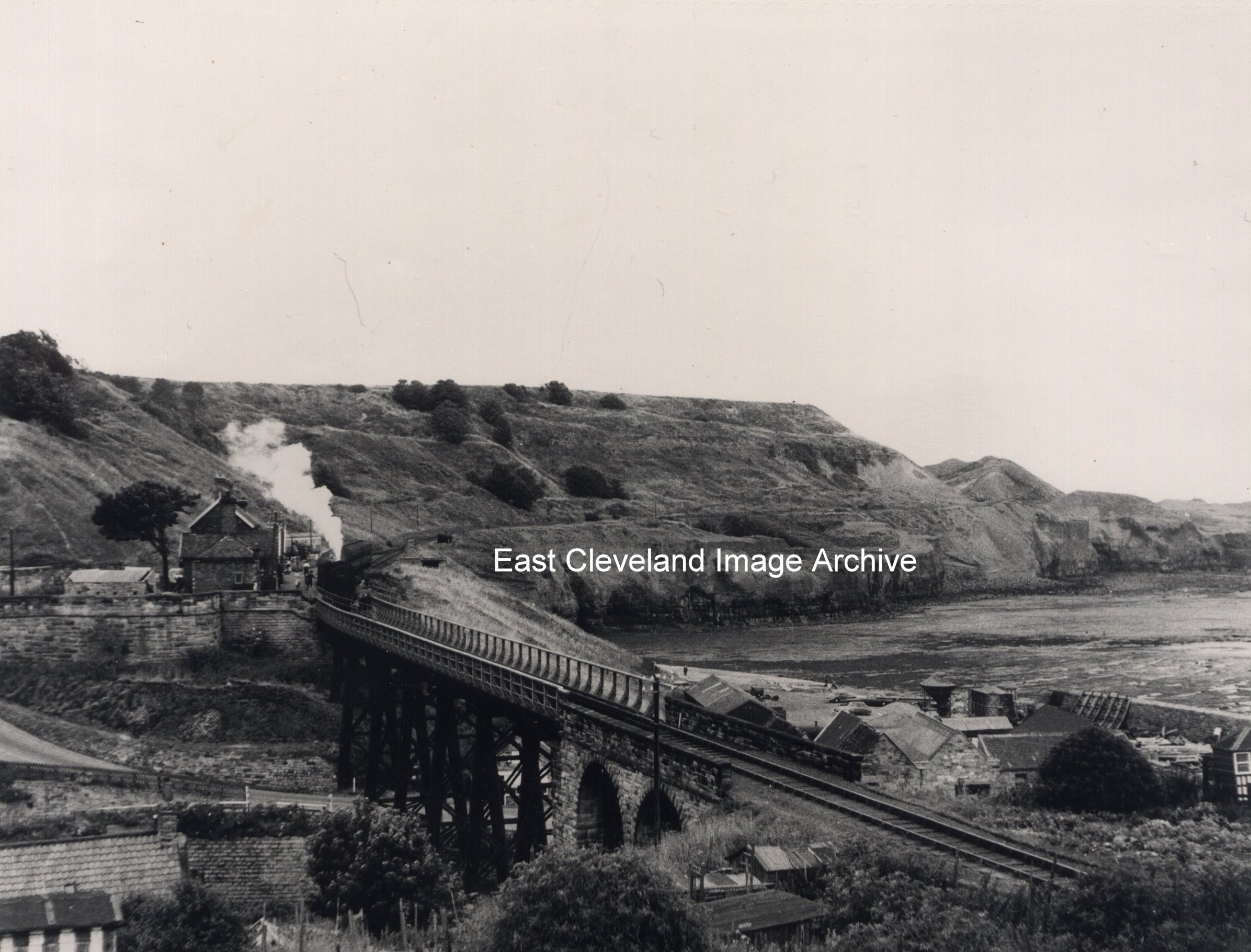
Another picture of the viaduct adjacent to the station at Sandsend, viewed from the hill above the village on the Whitby side. In the present day the former railway line is an excellent footpath and part of the Cleveland Way.
|
|
||
 Another picture of the viaduct adjacent to the station at Sandsend, viewed from the hill above the village on the Whitby side. In the present day the former railway line is an excellent footpath and part of the Cleveland Way. 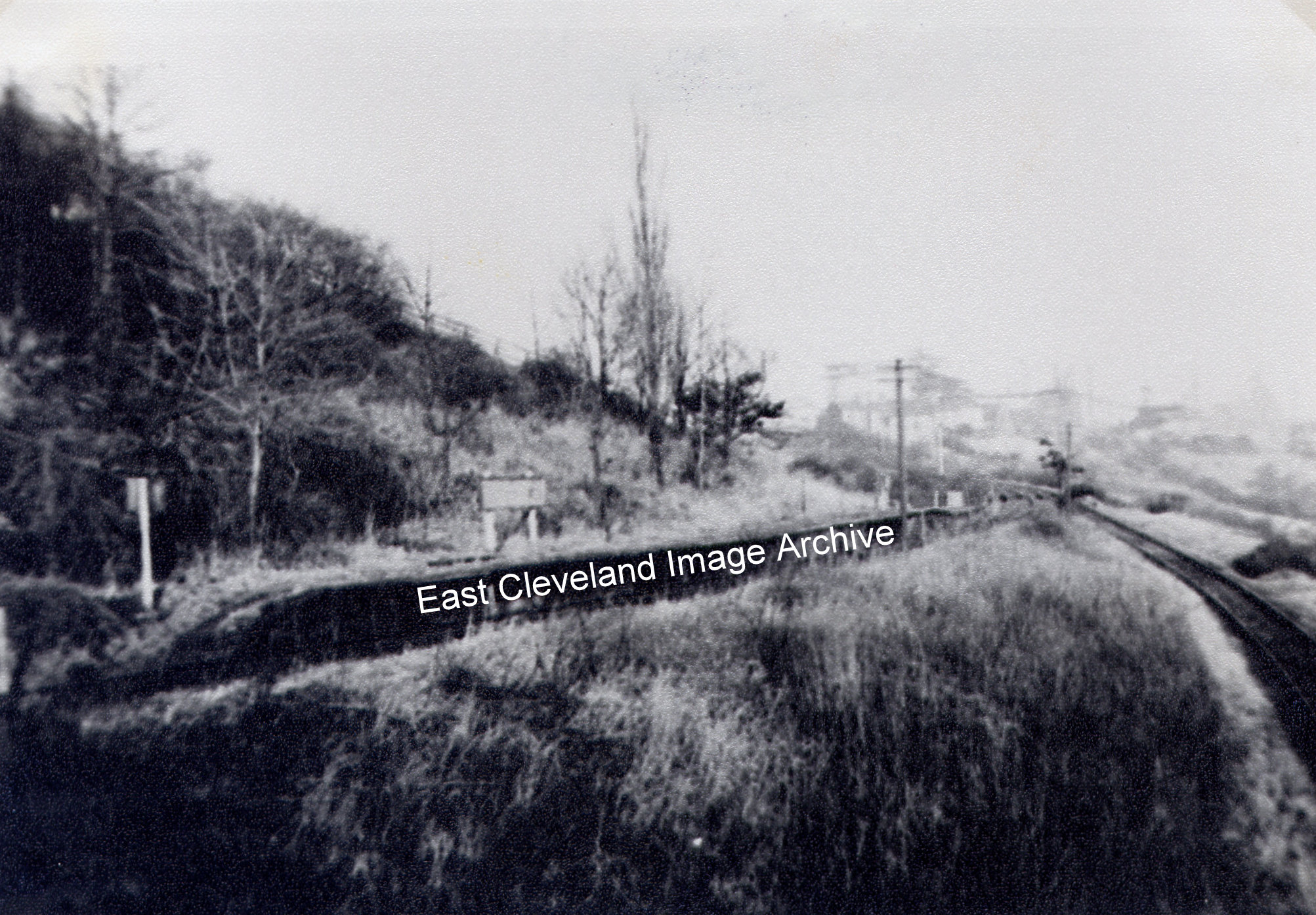 A photograph taken after Skinningrove station was closed; signboard and platform are all that remain!
Sandsend Viaduct, with local train – was how we originally posted this image. But alas we got it wrong! – it is a view of East Row Viaduct in the 1956 with a local commuter train from Whitby approaching. Sadly this picturesque line, which skirted the coast all the way from Saltburn to Whitby and from Whitby to Scarborough, has vanished, leaving only the mineral railway from Saltburn to Boulby Potash Mine. The locomotive leading this mixed passenger/goods train is an ex-Great Central Railways Robinson A5 4-6-2 Pacific tank; well at home on this demanding coastal line. The quaint seaside shop shown in the bottom right hand corner of the image still exists, doing an excellent trade of refreshments and beach essentials, weather permitting! Mark advised us: “Sorry to be picky, but this is East Row viaduct (Sandsend viaduct being the one adjacent to the station). Having said that, goods for Sandsend were handled at East Row, the Goods Shed (just visible in the background) remained in place until the early 1990s. Parts of the viaduct’s pier foundations can still be seen on the beach.” Meanwhile the goods shed site mentioned by Mark in the background are currently being developed as an upmarket housing development by the Mulgrave Estates. Image from the Neville Stead Collection, many thanks to Mark for pointing out our mistake! 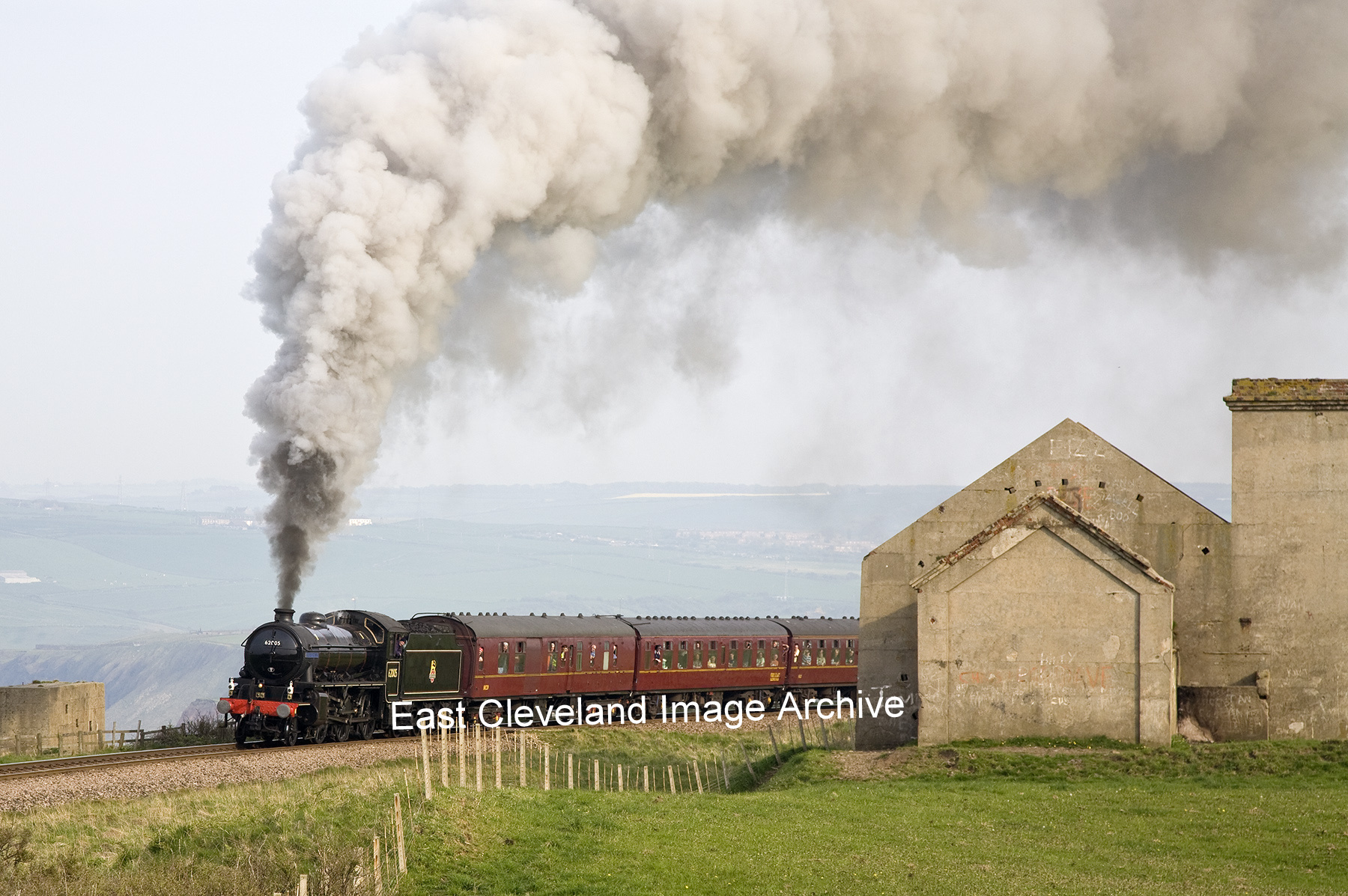 Preserved K1 Class, 62005, rounds the bend at Huntcliff, passing the remains of the old Guibal Fanhouse on a Train spotter’s Special on the 10th May 2008 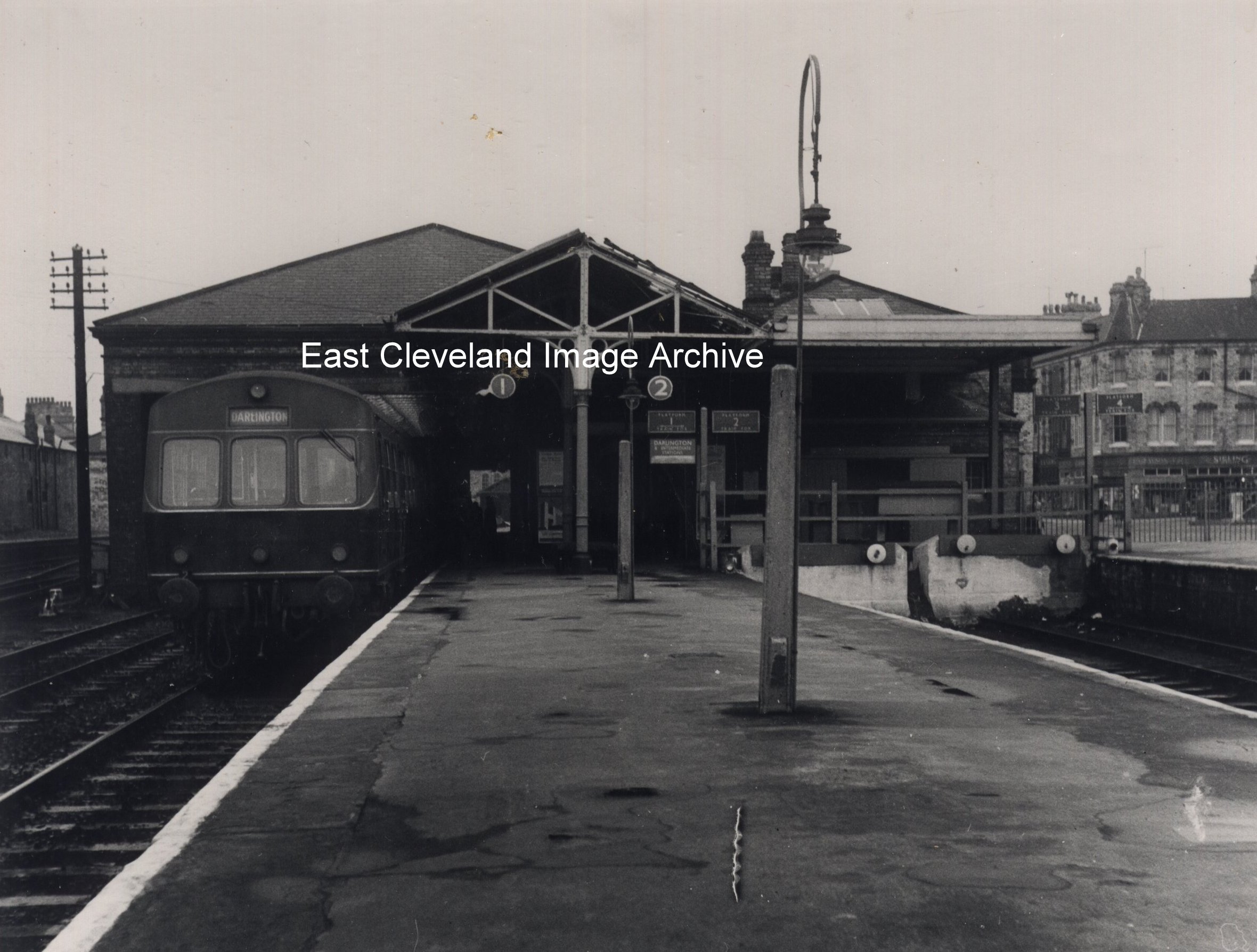 Another memory jogging photograph of when the train could pull right up to the Zetland Hotel in Saltburn. Russ Pigott advises: “Interesting picture, must be about 1956/7, the train which was to become a Class 101 in later year does not yet have the ‘speed whisker’ applied to the front and also the platform canopy had yet to be extended in concrete towards Redcar. Interesting to compare this to the 1980s picture I submitted (Class 101 DMU Saltburn) as the shop visible in the corner hardly seems to have changed, and although the train is the same type the platform in in this picture had been out of use since 1970 Image courtesy of Mike Holliday, thanks to Russ Pigott for the dating and update. 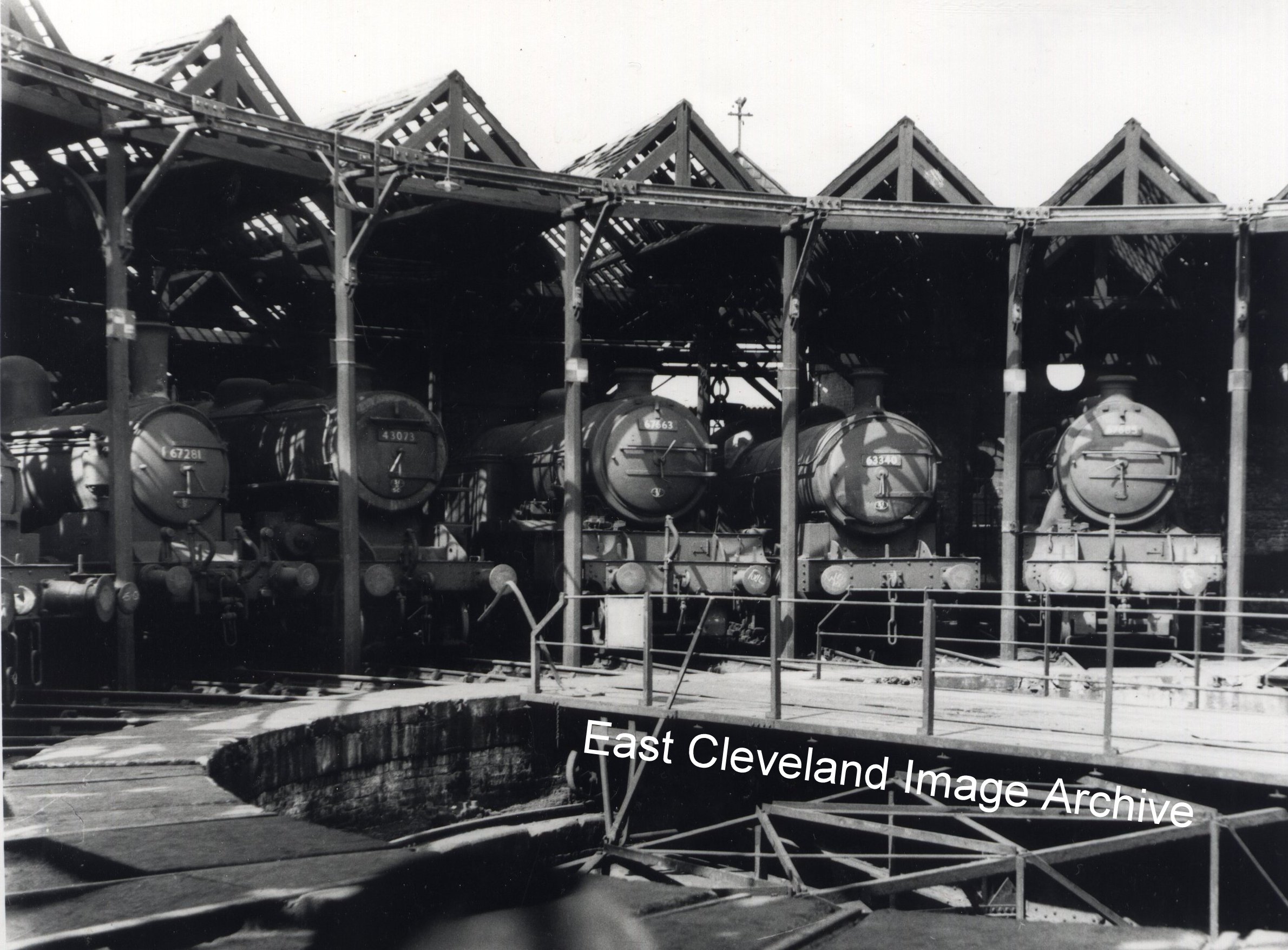 When first posted the Archive asked: “Now you train spotters out there where is this? I know you will be able to tell us, just reminds us of Thomas the Tank Engine!” Derick Pearson advised that the turntable was at Middlesbrough. Russs Pigott advised: ”The image shows (left to right) 67281; was the last surviving example of a G5, She was an 0-4-4T type. She was withdrawn by British rail in 1958. 43073. is definitely a Ivatt Class 4 and the last photograph I have of her is leaving Roose Railway station, Barrow-in-Furness in 1960. Where she ended up I do not know. 67663. Was a V1 2-6-2T Gresley. The Class V3 Gresley was introduced 1939, built on the same chassis and everything else. Appearance was much the same as the V1 but the V3 had a Higher Boiler Pressure. This one is the earlier V1. 63340. Is a Q6; it was originally a N.E.R class T2 0-8-0. Classified as a Q6 by the L.N.E.R. 120 were built at Darlington works between 1913 and 1921 to the design of Vincent Raven. They were based on the N.E.R Class T and T1- L.E.N.R – Q5s. All passed into British Railways ownership in 1948 and they were numbered from 63340 to 63459. 63372 was withdrawn in 1960 after an accident. The others were withdrawn from 1963 to 1967. Only one of them, the 63395 has survived to preservation on the North Yorkshire Moors Railway. She re-entered service after a major overhaul in 2007. 67685. Was A Gresley 3 cylinder V3. The last reference I have to her is at Battersby Junction near Gt Ayton. Hope this sorts that one out.” Image courtesy of Mike Holliday and others, also now known to have been on a CD produced by Derick Pearson. 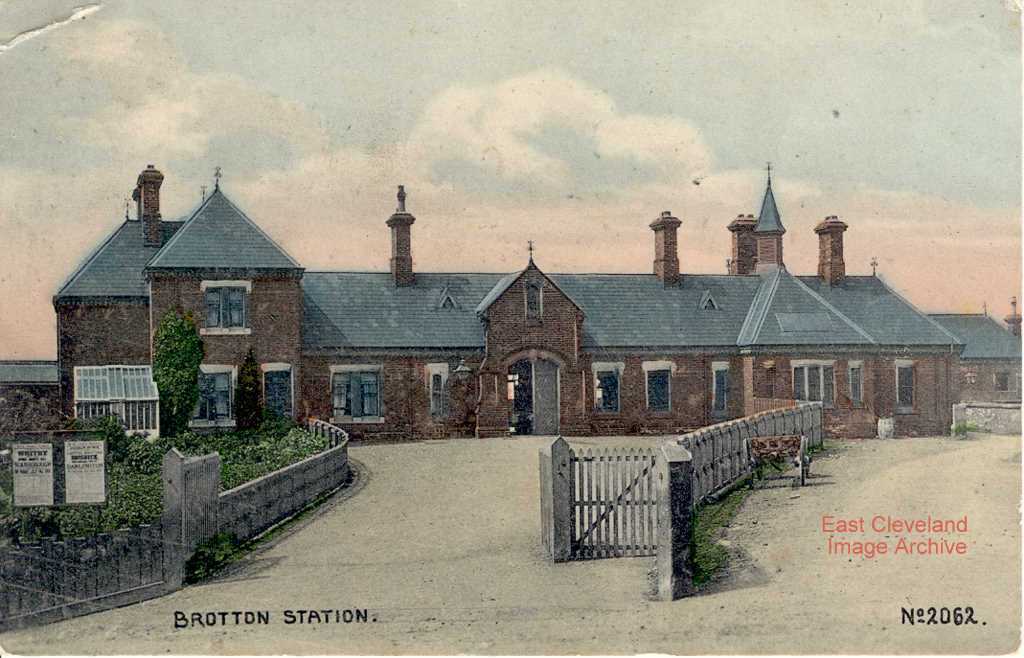 An excellent hand tinted postcard of the railway station in possibly 1907, one of the ”Phoenix” Series produced by Brittain & Wright of Stockton. It looks so different now. Image courtesy of John G. Hannah. 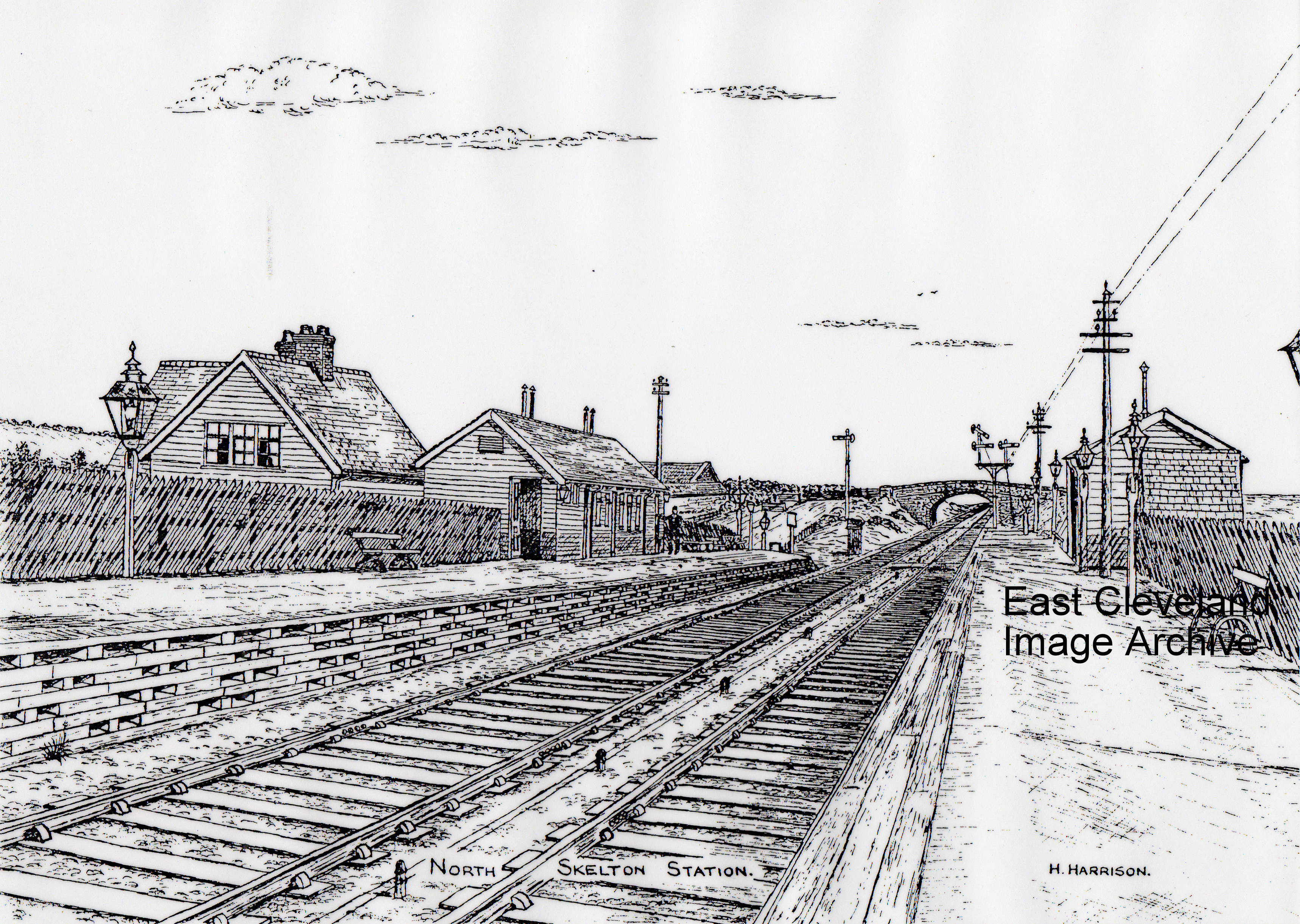 Skelton station as we have never seen it, once again a lovely drawing, the station was South-East along the railway from Hollybush Bridge. David Richardson tells us: “It opened on 1st July 1902 and was closed to passengers on 10th September 1951; closing completely on 21st January 1964. The building to the left of the picture was the Station Masters house which still stands. Derick Pearson assisted with: “North Skelton Station was at Hollybush where Wilkinson Brothers Car Breakers yard is sited.” Locals can remember some platforms still being there and we believe this is the one depicted in the etching. Stonehouse Brothers had the yard for coaches before Wilkinson Brothers; a little further along the line was Long Acres Pit which is also shown on site. Image courtesy of Joan Webster and thanks to David Richardson and Derick Pearson for updates. 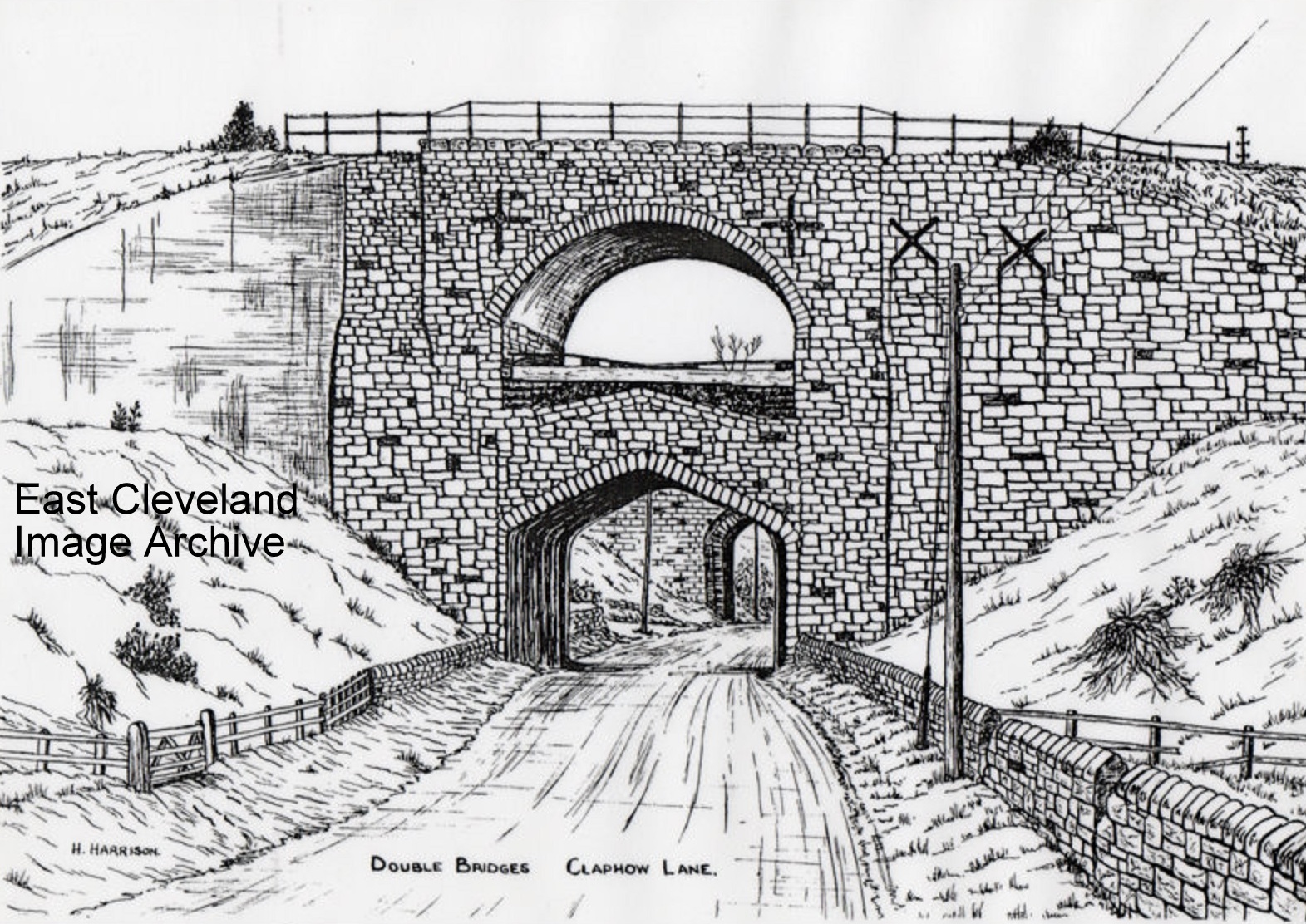 Yes I know we have a photograph of this bridge, but not like this. Look at all those bricks; how long to draw all those? 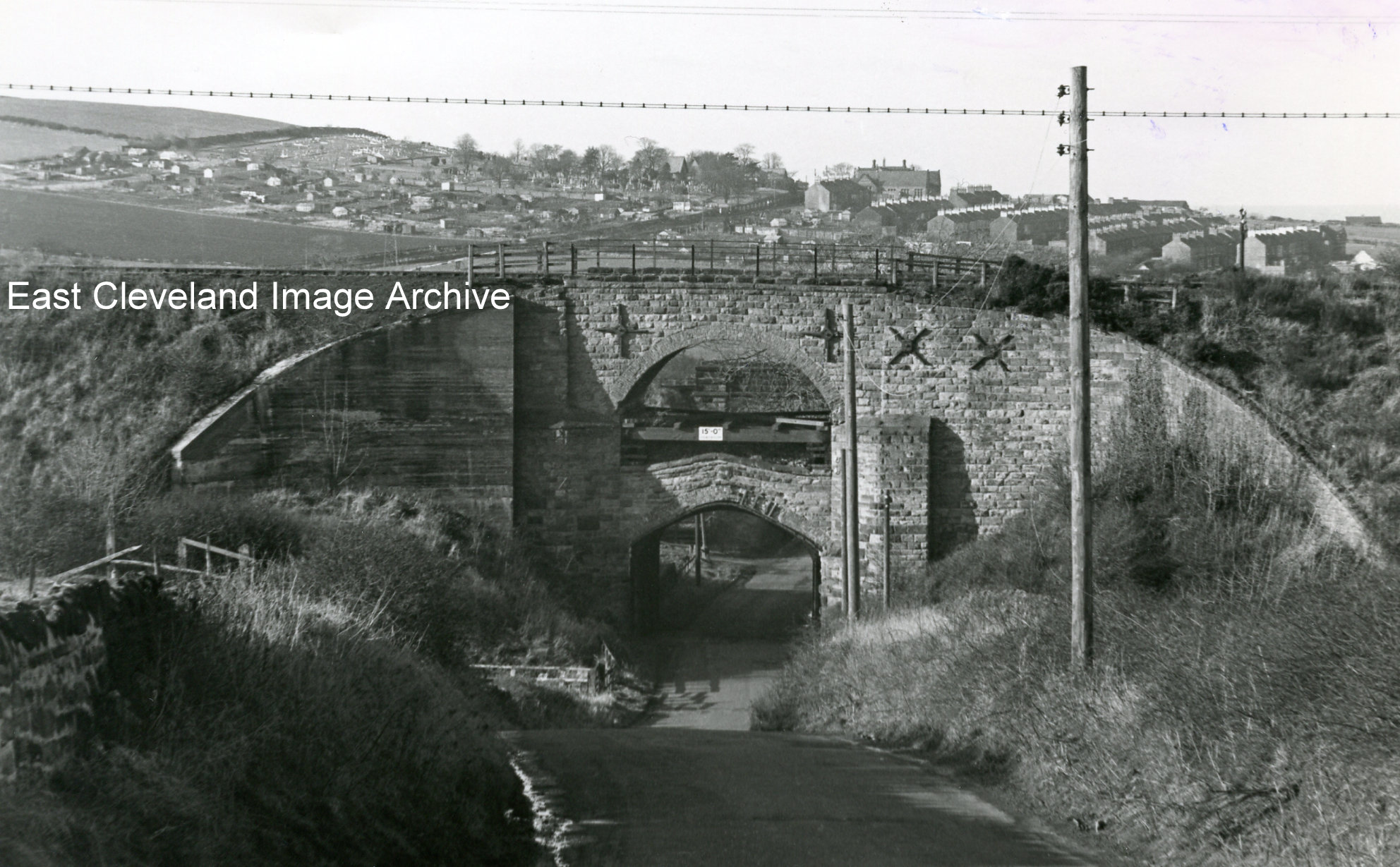 One of the two rail bridges at Claphow, Stanghow Road (the road connecting New Skelton directly to Lingdale). Due to mining subsidence the bridge was strengthen with the addition of a second arch inside the original arch. A buttress was added at the right hand side and four iron rods inserted through the parapet, whilst the left hand side was concreted. Andrew Pearson tells us: ”Really good photograph, looks to be from around 1964 or maybe early 1965. The railway was part of the much missed coastal route down to Whitby and Scarborough from Middlesbrough which closed completely in May 1958 between Loftus and Whitby West Cliff, passenger trains continued to run to Loftus until 1960 and then only to Guisborough until 1964 when it too closed under what came to be known as the Beeching Axe, which was to devastate the UK rail network. By this time the only traffic across this bridge was the weekly goods (mostly coal), to Boosbeck public delivery siding, from the Brotton direction, which ended in September 1964 when the depot at Saltburn took over coal deliveries enabling this line to be closed altogether. The line from Guisborough meantime had been cut just before reaching Boosbeck and was used for the storage of redundant wagons for the last five years of its life. During the summer of 1965 all the rails and fittings were uplifted from Brotton junction to the Esk Valley line junction near Nunthorpe inclusive, and this bridge was subsequently removed during improvements to the Lingdale to Skelton road. The other bridge behind it in the picture, on the Priestcroft Junction to Skelton triangle line, is still there.” Alastair MacKenzie adds: “I recall this too and think it was demolished in early 1970’s. Andrew is correct but doesn’t mention that the other leg of the triangle is still in use for the potash trains. This takes off at North Skelton and re-joins what would have been the triangle at Brotton. As a child living at Boosbeck, I recall seeing many iron-stone and passenger trains on this triangle. Often at night particularly if cold and frosty, the finished steel product trains to or from Skinningrove could be heard. The playing field behind our house at Wandhill, Boosbeck; looked onto the Boosbeck end of the triangle at Priestcroft. I never saw this personally but it is known that excursion trains from places like Leeds and Bradford, coming to Redcar and Saltburn, would run up to the triangle to be turned as the turntable at Saltburn was too small for loco’s like the V2. They would run up coupled in twos and threes to turn by reversing onto one or other leg.” Andrew Pearson confirms this: “The other leg of the triangle is part of the Saltburn – Boulby line which is very much still with us and in regular use but singled throughout, where before it was double track from Saltburn Junction through Brotton to Carlin How and then single track on through to Whitby/Scarborough with passing places at Loftus, Staithes, Hinderwell, Kettleness, Whitby West Cliff then Robin Hood’s Bay, Ravenscar, Staintondale and Cloughton. Opened in 1872(goods) and 1875(passenger) as the ‘Saltburn Extension’ the line served ironstone mines at Longacres, Lumpsey and Brotton in their time as well as Skinningrove Works now also Boulby Potash (rebuilt 1974 from Carlin How with a new viaduct) and it occasionally even sees steam hauled specials the most recent of which ran as far as Carlin How and back on March 30 2013. Intermediate stations were North Skelton and Brotton. Passenger services between Saltburn and Brotton ended September 6 1957 and between Loftus/Brotton/Guisborough April 30 1960 but goods services continued thereafter as in my previous post as well as mineral workings Lingdale Pit until 1962, Kilton (1963) and North Skelton (1964). Callum Duff asked: “I’m convinced that this bridge existed until around 1975 because I remember my Dad driving under it when I was a child and me being intrigued by such an unusual structure. Does anyone else know for sure when it was actually demolished?” Andrew responded with: “Not too sure as to the exact date but 1975 would be about right as it was definitely missing by 1976 when I happened to pass that way. As can be seen in the picture, the road was very much still a country lane and not suited to the ever increasing traffic even back in the 70s, never mind now when speeds are dangerously high so improvements were a priority on safety grounds. The bridge had been in a poor condition for a long time due to mining subsidence, it presented a bottleneck and once its rail function ended it would have had little further purpose.” Image courtesy of Ted Morgan (via Eric Johnson), with information from Eric Johnson; also thanks to Andrew Pearson, Callum Duff and Alastair MacKenzie for the updates. |
||
Recent Comments